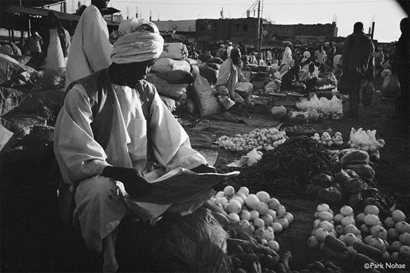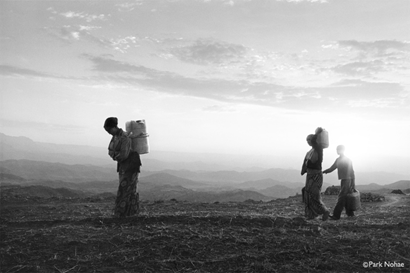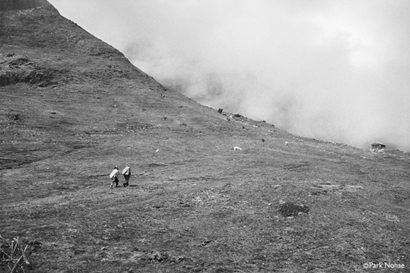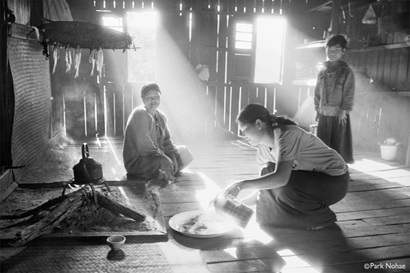Censorship could not prevent the publication in 1984 of the first collection of his poems, Nodongui saebyeok (Dawn of Labor). It was a bombshell, something totally new. There had been dissident poets before him, of course, in the 1960s and 1970s. Shin Gyeong-nim had been one of the first, writing about the anguished lives of poverty-stricken farmers in Farmers’ Dance. Ko Un had read stirring poems at the start of many protests throughout the 1970s and beyond. Kim Chiha had spent long years in prison for his dazzling satire of social corruption, Five Bandits, and had become an internationally known cause célèbre. But here was a real worker, at grips with the daily agony of workers, who could write powerful poetry! It was unheard of! In the years that followed, book sales soared, ultimately nearing a million copies. Every Korean student read it. The police were on the highest alert, though in vain.
In Dawn of Labor, poem after poem gives voice to the voiceless workers surrounding the poet in his daily life. They simply express their feelings, caught as they are in a system where the wealthy factory owners have complete power over those they employ for a pittance. Exhaustion, poverty, lack of free time, the threat of unemployment, and the daily grind of working life, are brought alive in a muted way, suiting the gravity of the situation. The opening poem expresses many of the volume’s main themes:
Many of the poems express bitterness and sorrow, the frustration of young working couples who almost never have time to be together, or the pain of having a day off but being too poor to go anywhere or do anything. Yet sometimes a flash of humor shines through, as when a group of workers go to renew their residence registration, which involves having their fingerprints taken, only to discover that their fingers have been so corroded by industrial chemicals that they have no fingerprints left to give, just as they have virtually no identity in society.
Heaven
My family of three depends for its living on my boss, so
he’s my heaven.
When I go to hospital cradling a hand crushed in the press,
the doctor can patch it up or leave it crippled, so
he’s my heaven.
Carted off to the police station for organizing a labor union
after two months without pay,
the policeman who says he’s going to have us locked up
though we’ve never once committed a crime
is an always frightening heaven.
The judges and prosecutors
who can turn us into criminals or save us
are a dreaded heaven.
The officials
sitting in government offices who can make us or break us
are a scary heaven.
High-up people, people with power, people with wealth
all look like heaven,
and indeed, they really are a black heaven
controlling our lives.
Can I ever become a heaven
for someone somewhere?
Powerless, I have ever lived at the very bottom, so
there is only one person,
one just beginning to toddle about,
our so lovely little baby,
for whom I am a small, shaky heaven.
Ah, we too want to be a heaven.
Not a black-clouded heaven weighing down.
We want to be a world where each of us is a blue heaven for everyone,
supporting one another.
Naturally, some people knew who he was and where he was (by now) hiding. None betrayed him. In Park Nohae’s view, the challenges facing Korea’s workers were essentially communal. Obviously, individuals were powerless alone. Union activities sometimes existed, but they were limited to individual factories where it was easy to identify leaders and have them fired or arrested. Park Nohae was in close contact with groups of thinking people who saw the need for a much broader social and political solution—a collective, revolutionary solution. Since the Korean War, and even before it began, in South Korea the word “socialist” meant “communist,” the word “communist” meant “commie bastard,” and for tens of thousands of innocent people that label had been enough to result in their brutal death without trial or appeal. In 1989, with a new military president installed, Rho Tae-woo, but with increasing recognition of the need for a return to purely civilian, democratic government, Park Nohae and a group of fellow radical activists launched the “South Korean Socialist Workers’ Alliance.” Socialist? The South Korean security forces were put on red alert. Arrests followed. But it was only on March 10, 1991, that Park Nohae was arrested. By that time, he probably felt that his life underground, constantly on the run, had served its purpose. His true name became known, Park Gi-pyeong, and he was finally caught.
The Korean system of justice treated him as it felt a poet of his standing deserved to be treated. He was taken to a notorious building on the slopes of Seoul’s Namsan, where the Korean intelligence agency had for decades tortured, and sometimes killed, its victims. There, in an underground chamber, he was subjected to as much torture as the age now allowed. For twenty-four days and nights, he was subjected to physical and mental violence. To survive, he clung to the phrase: “Just one day more! One day more! I’ve survived this far, surely today’s my end, the last day of my life. So just this one more day, today! One more day, until my last minute, and death!” His tormentors were intent on discovering the full extent of his activist network. He knew that if he ever began to yield, they would demand another name, then another, so he kept silent. At the end of those twenty-four brutal days, he was finally produced to public view on his way to court. For the first time, the faceless poet was given a face, and to the stupefaction of those who knew what he had just endured, he was smiling broadly, joyfully, on television screens and in photos published in all the newspapers.
Once his trial began, the justice system paid him the highest tribute a poet can receive. The prosecution accused him of being “an enemy of the state” and demanded the death sentence. Certainly, insofar as the South Korean state was complicit in the oppression and exploitation of millions of workers—humble, helpless citizens—Park Nohae was an enemy of the state. Finally, the sentence given was a slightly milder one: life imprisonment. He was taken to a prison in Gyeongju, in the far southeast of the country, and he began his life in solitary confinement in a tiny, unheated cell. For most prisoners placed in solitary, the discomfort and loneliness soon become intolerable. For Park, it was a gift. Sentenced in 1991, by 1993 he published a collection of poems written in prison, Chamdoin Sijak (True Beginning). It sold thirty thousand copies in the first month, sixty thousand in the first year. These poems about his arrest, torture, trial, and imprisonment were a far cry from the poems about life as a worker. They are a record of near collapse, recognition of failure, of inner and outer torment, but they are also a message of hope, a celebration of survival. The poem “The Winter Tree that Year” is the most celebrated expression of that:
The Winter Tree that Year
1
Winter that year was pallid.
People hunched critical shoulders or suffered death,
bodies quaking they said either “Not now,” or again, now again,
“That blue dream will not return.”
The bitter north wind blowing from Moscow shook the world
as it bore away in a flash once-fluttering leaves, birds, and songs, too.
From the ashen sky, flocks of crows swooped down as if to arrest me,
binding my weary body with merciless cords.
In winter that year,
my beginning was my defeat.
(. . . .)
3
Nobody could say when the winter would end.
Haggard faces, seeming dead, sick with self-criticism,
knew full well that there was nowhere, nowhere they could stand secure.
Thickening joints, increasing growth rings, the roots raised red frozen hands
produced and raised moist light for themselves.
Only the green, rising within its blood and bone, was its faith that winter.
A worm of desire came down, crept into the ropes binding its waist,
and finally the winter tree plucked off the ropes attaching it, coughed deeply and blazed up.
A biting night wind raged and all through the winter, only an aching silence reverberated like a bell within.
All kept silent but believed for sure that that long silence
was the first step toward a new birth.
In winter that year,
my defeat was my true beginning.
In the following years, Park Nohae turned his imprisonment into a process for spiritual discipline and growth. He shaved his head, rarely spoke, and wrote nothing except the poems that arose in the silence. For hours each day he would sit, facing the wall, like a Buddhist practitioner of Zen (in Korean “Seon”). While in the outside world, South Korea’s social evolutions continued and the first civilian president was sworn in early 1993—a symbolic step towards the long-hoped-for democracy—Park Nohae remained in prison. In 1997, he published another collection of poems at the same time as a campaign was developing for his release. Sarammani huimangida (Only a Person Is Hope) is a collection of poetic essays on the themes that had preoccupied Park during his years of silence. The collection starts with an account of a chance conversation between Park, on his way to prison after sentencing, and a simple worker on her way to be released. The woman recognizes him and starts to express her inmost thoughts about social activism:
“I hope for a good world, but honestly speaking I want it for free.
A good world, a good world, I say,
but I am jealous of the riches and abilities of the wealthy.
I’ve lived by stealing our children’s future,
stealing the happiness that is due to those who make sacrifices for a better world.
(. . . .)
“With no attempt to be a good person first,
with no concrete action to participate and support
by sharing out my little money, time and attention,
how can I hope for a better future, and for whom?
The good world is, in some ways, already growing inside us.
(. . . .)
“With whose strength and over what length of time
can such a good society be established?
When will we selfish workers and ordinary people
ever change into mature adults?”
Faced with her naive question
I crumbled completely.
Faced with this one woman, who lives by the diligent sweat of her brow,
faced with the question she asked from the depths of her life,
faced with her stern question, dropping on me like a ton of bricks,
ah, I lay helpless, crumbling, broken.
(. . . .)
All through the past seven years I have experienced death behind these walls.
Finding out “why I should go on living” as a failed revolutionary
was a desperate challenge. It was dreadful.
The riddle that woman gave me that evening required me
to be honest, even if it killed me, to take responsibility for the result,
it demanded a life of aching silence in which I stopped writing, shaved my head, a life of self-discipline.
And now, after much time has passed,
I hear within me the sprouting of fresh buds.
At last, quiet hope.
The fact that I have survived and did not die,
that is my hope.
Until the day when I can stand with confidence
before the woman whom heaven sent me that evening,
my waiting and self-discipline will continue.
The entire collection is an attempt to express in verse the kind of life required if the world is to become a better, more just, more human place. Then in 1998, a democrat, Kim Dae-jung, became the new president of Korea. On August 15 that year, Park Nohae was amnestied and emerged from over seven years of solitary confinement.
Once Park Nohae had reestablished contact with those who had been his companions before, and those new companions who had been deeply moved by the two prison collections, he put into practice the most important notion his reading in prison had confirmed. Nothing was more important, he felt, nothing more truly human, than community, the community that arises when people live and share together. One essential source for this vision was his experience of rural village life in his childhood, the farming community where all shared the burdens, the sorrows, and the joys of a life deeply rooted in nature. In 2000, he established a nongovernmental organization, named “Nanum Munhwa” (Culture of Sharing), bringing together people thinking along the lines he had laid down, aimed at social transformation. Refusing financial support from the government or business conglomerates, the work of the organization was self-sufficient, financed through member-paid dues, because only then could it retain its freedom of action.
The most striking transformation for many, however, was the poet’s shift from Korean social issues to global issues. He made headlines in 2003, when the United States invaded Iraq, by going alone to Iraq to be with the children weeping in terror because of the war, part of a human shield to protect civilians and promote peace. In 2006, he went to Lebanon on a similar peacemaking mission, publicly opposing the dispatch of Korean troops to the Middle East. In the years that followed, he visited many places where people were suffering from war, violence, and poverty: Palestine, Kurdistan, Pakistan, Aceh (Indonesia), Burma, India, Ethiopia, Sudan, Peru, and Bolivia. During these visits, he carried a small camera and began to record the daily lives of the ordinary people he encountered. He carried a notebook for poetry, but in a sense his photos—almost always in black and white—became a major part of his poetic output. In 2010 the first exhibition of his photos was held in Seoul, then in 2012, Culture of Sharing opened Ra Gallery and Cafe in northern Seoul. Since 2010, some three hundred thousand people have visited his exhibitions.

Khartoum, Sudan, 2008. DAWN MARKET IN KHARTOUM. In the desert, where the Blue Nile and the White Nile meet, the celebrated Khartoum dawn market is being held. Is there any other market as vibrant with such rich, varied, tidy, vivid vitality? After carefully stacking onions he has grown, a merchant opens and reads a precious newspaper that many read in turns. Eating and living are the first priority, of course, but I need to know how the world I live in is going. He reads about the world with bright morning eyes.

Lalibela, Ethiopia, 2009. DRAWING WATER AT DAYBREAK. Daybreak is life’s mystery. When night comes walking then the sun rises again, a new life begins. As day dawns in the Ethiopian Highlands, I return home from a long journey to draw water. With this water, I will wash rice, wash myself, and quench the cattle’s thirst. My steps bearing such a burden are heavy and slow but if there is love and hope in the weight of this life’s burdens, the strength to endure is given. I have ever lived day by day. I am touched, give thanks, endure.

Cochamuco, Cusco, Peru, 2010. SETTING OUT AGAIN AT DAWN. Any who have come a long way will know, any seeking a path today will know, that here is not my abode,* that my own path is calling me. Oh, I am a wanderer between two worlds, a pilgrim ever walking on in search of a path. Every day is a good day. Once again I set out at dawn.

Palaung village, Kalaw, Burma, 2011. SUNLIGHT IN A TEACUP. The daily routine in high mountain villages starts before sunrise. As day dawns, they draw water, pick greens, feed the cattle and sweep the garden, what has to be done today is done quickly. Finally, as the sun rises, they wash themselves and prepare tea. In the morning fish dry savory in the smoke from the fire and the family pass round cups of tea and chatter. The life that comes shaking off darkness teaches. As we open our eyes each morning, we see a world dazzling in sunshine. What a wonder that another day has been given to me! What a great blessing it is to drink tea infused with sunshine and see each other’s smiling faces!
In 2010, Park Nohae finally published a new collection of over three hundred poems, Geuroni geudae sarajiji marara (So, You Must Not Disappear) on the themes of resistance, living, revolution, and love. Many poems are based on vivid memories of the poet’s childhood, or of individuals he met during his travels. Today, living in a remote rural community, he continues to engage in simple farming, and to write. A new book is eagerly awaited. He rarely visits Seoul, but he came every week to participate with core members of Culture of Sharing in the Candlelight Demonstrations, which began in October 2016 and finally removed President Park Geun-hae from office. Most recently, in June 2019, came the opening of a new and larger Ra Gallery and Cafe, close to Gwanghwamun in the center of Seoul.
Little remains to be said. Park Nohae was born and grew up as Park Gi-pyeong. Born in 1957 in Hampyeong, South Jeolla Province, in the southwest of South Korea, he grew up in a farming town, Beolgyo, part of Goheung. His father participated in Korea’s progressive movements, including the independence movement against the Japanese, and his mother was a devout Catholic. Both greatly influenced him during his childhood. But when he was only seven, his father died suddenly, and his mother, reduced to poverty, found herself obliged to send the children to live with various relatives, while she herself worked in factories.
Virtually none of Park Nohae’s poetry has been published in translation. For the world at large, he still remains a faceless poet. Last year, the Culture of Sharing approached me with a request to help translate Park Nohae’s poems, since they were eager to make his life and work known overseas. They took those samples to the Frankfurt Book Fair, hoping to find interested publishers, with no great success. Since then, draft translations of the collections Dawn of Labor, Only a Person is Hope, and So, You Must Not Disappear, have been completed. True Beginning remains to be translated in the coming time. Park Nohae’s work is intended to inspire and sustain all who hope for a world of justice, equality, and sharing, wherever and whoever they may be.
The poet wrote a preface to a volume of photos, One Day, which featured people from around the world engaged in their daily lives with poetic captions in Korean and English. He concluded: “All I can and must do with my camera is to recognize, venerate, and love the people of hidden light. My photos and writings are intended to help recognize the true form of the good life and noble humanity found in the ordinary days of ordinary people, and convey a “seed of hope” to each pure heart.”
